|
February, 18
|
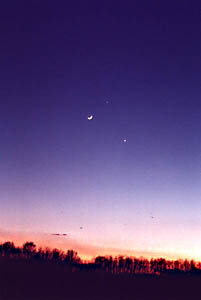 This
image is one of the first that I took the evening of February, 18: the
show was fantastic, a thin scythe of Moon go with two bright points (the
more bright is Venus); they formed an isosceles triangular pointed in the
direction of where the Sun sets, as if they would like to say that the
show was possible thanks to the Sun that illuminates them. This
image is one of the first that I took the evening of February, 18: the
show was fantastic, a thin scythe of Moon go with two bright points (the
more bright is Venus); they formed an isosceles triangular pointed in the
direction of where the Sun sets, as if they would like to say that the
show was possible thanks to the Sun that illuminates them.
Technical data: 50mm
objective, camera mounted on a fixed tripod. 1 second at f/16 on Kodak
PJ-400 film. Taken from Tradate (VA, Italy). |
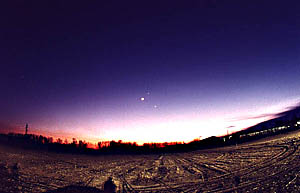 A
wide field view of the panorama. There was a soccer field at few meters
that illuminates the ground under the conjunction. There is also my shadow
projected on the ground. A
wide field view of the panorama. There was a soccer field at few meters
that illuminates the ground under the conjunction. There is also my shadow
projected on the ground.
Technical data: 16mm
objective, camera mounted on a fixed tripod. 4 seconds at f/5,6 on Kodak
PJ-400 film. Taken from Tradate (VA, Italy). |
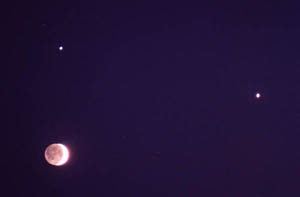 With
a telephoto lens we can see better the triple conjunction: it's very interesting
to see the cinereous light, that bright part of the Moon that isn't directly
illuminated by the Sun, but from the light reflected by the Earth. If you
note Jupiter (top left) you can see some points of light: they are the
Galilean satellites. With
a telephoto lens we can see better the triple conjunction: it's very interesting
to see the cinereous light, that bright part of the Moon that isn't directly
illuminated by the Sun, but from the light reflected by the Earth. If you
note Jupiter (top left) you can see some points of light: they are the
Galilean satellites.
Technical data: 200mm
objective, camera mounted on a fixed tripod. 4 seconds at f/3,5 on Kodak
PJ-400 film. Taken from Tradate (VA, Italy). |
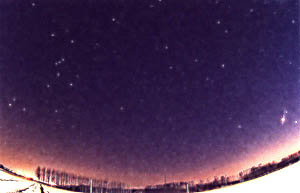 When
the twilight ended, the stars become visible, this wide field photo shows
many constallations: from left there is Canis Major with the bright Sirius;
at right there is Orion; if you go in the direction of the Orion belt,
you'll find Aldebaran in Taurus; but if you follow the direction of Venus
and Jupiter, you'll find the planet Saturn. When
the twilight ended, the stars become visible, this wide field photo shows
many constallations: from left there is Canis Major with the bright Sirius;
at right there is Orion; if you go in the direction of the Orion belt,
you'll find Aldebaran in Taurus; but if you follow the direction of Venus
and Jupiter, you'll find the planet Saturn.
Technical data: 16mm
objective, camera mounted on a fixed tripod. 30 seconds at f/5,6 on Kodak
PJ-400 film. Taken from Tradate (VA, Italy). |
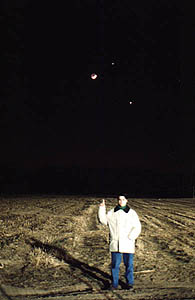 If
you don't understand about what I was writing above, beh, here is the indication!
:-)) For taking this image I used the light pollution from the very near
soccer field. If
you don't understand about what I was writing above, beh, here is the indication!
:-)) For taking this image I used the light pollution from the very near
soccer field.
Technical data: 50mm
objective, camera mounted on a fixed tripod. 1 second at f/1,8 on Kodak
PJ-400 film. Taken from Tradate (VA, Italy). |
|
February, 22
|
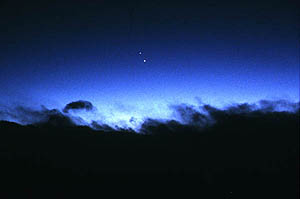 Here
is the evening sky four days after the conjunction with the Moon: Jupiter
(above) and Venus (below) are less than a degree apart, and continue to
approach themselves. Here
is the evening sky four days after the conjunction with the Moon: Jupiter
(above) and Venus (below) are less than a degree apart, and continue to
approach themselves.
Technical data: 50mm
objective, camera mounted on a fixed tripod. 1/2 second at f/2,8 on Kodak
EliteChrome 200 film. Taken from Tradate (VA, Italy). |
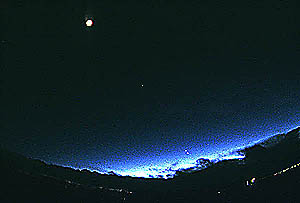 In
a wide field view we can easily imagine where the ecliptic is, the plane
in which all the planets and the Moon move (in first approximation). From
bottom right: Venus, Jupiter, Saturn, Moon. In
a wide field view we can easily imagine where the ecliptic is, the plane
in which all the planets and the Moon move (in first approximation). From
bottom right: Venus, Jupiter, Saturn, Moon.
Technical data: 16mm
objective, camera mounted on a fixed tripod. 3 seconds at f/4 on Kodak
EliteChrome 200 film. Taken from Tradate (VA, Italy). |
|
February, 23
|
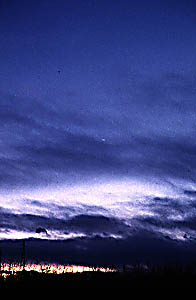 And
now the great day: February, 23. The planets Venus and Jupiter are very
near, olnly 9' of degree, only 1/3 of the Moon diameter. In the telescope
they are easily visible in the field of view of an eyepiece. Because of
the weather conditions I preferred to move South of Tradate, I went to
Legnano (MI, Italy), where with my friend Simone Bolzoni, we do the observations. And
now the great day: February, 23. The planets Venus and Jupiter are very
near, olnly 9' of degree, only 1/3 of the Moon diameter. In the telescope
they are easily visible in the field of view of an eyepiece. Because of
the weather conditions I preferred to move South of Tradate, I went to
Legnano (MI, Italy), where with my friend Simone Bolzoni, we do the observations.
Technical data: 50mm
objective, camera mounted on a fixed tripod. 1/2 second at f/2,8 on Kodak
EliteChrome 200 film. Taken from Legnano (MI, Italy). |
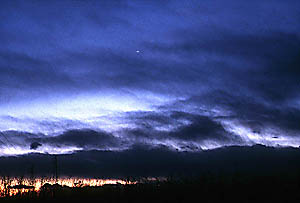 Another
image that show the unreal atmosphere created by the clouds at Sunset. Another
image that show the unreal atmosphere created by the clouds at Sunset.
Technical data: 50mm
objective, camera mounted on a fixed tripod. 1/4 second at f/2,8 on Kodak
EliteChrome 200 film. Taken from Legnano (MI, Italy). |
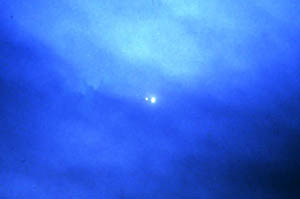 The
two planets were visible between a cloud and another. Here is a telephoto
view. The
two planets were visible between a cloud and another. Here is a telephoto
view.
Technical data: 200mm
objective, camera mounted on a fixed tripod. 1 second at f/3,5 on Kodak
EliteChrome 200 film. Taken from Legnano (MI, Italy). |
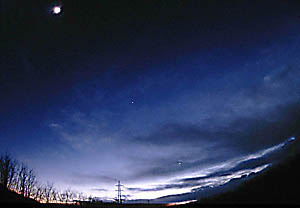 In
this image is visible the ecliptic: from bottom we observe Venus and Jupiter
(in conjunction), Saturn and the Moon. In
this image is visible the ecliptic: from bottom we observe Venus and Jupiter
(in conjunction), Saturn and the Moon.
Technical data: 16mm
objective, camera mounted on a fixed tripod. 4 seconds at f/5,6 on Kodak
EliteChrome 200 film. Taken from Legnano (MI, Italy). |
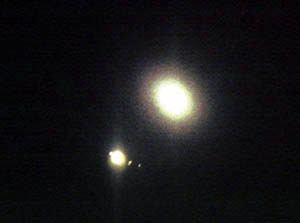 And
here is what we observe in the telescope: the very bright Venus with a
big bright halo, Jupiter also with a little halo. Near Jupiter there was
his Galilean satellites: from left we see Ganymede, then Io and Callisto
(in conjunction! one above other) and Europa. And
here is what we observe in the telescope: the very bright Venus with a
big bright halo, Jupiter also with a little halo. Near Jupiter there was
his Galilean satellites: from left we see Ganymede, then Io and Callisto
(in conjunction! one above other) and Europa.
Technical data: 20
cm Schmidt-Cassegrain telescope, used at direct focus of 2000mm. 10 seconds
exposure. Kodak EliteChrome 200 film. Taken from Legnano (MI, Italy). |
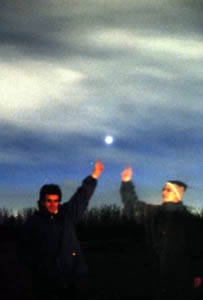 Finally
a picture that will remember that fantastic evening! (from left: Simone
Bolzoni and Lorenzo Comolli) Finally
a picture that will remember that fantastic evening! (from left: Simone
Bolzoni and Lorenzo Comolli)
Technical data: 50mm
objective, camera mounted on a fixed tripod. 30 seconds at f/2,8 on Kodak
EliteChrome 200 film. Taken from Legnano (MI, Italy). |